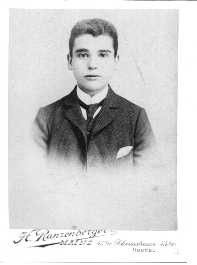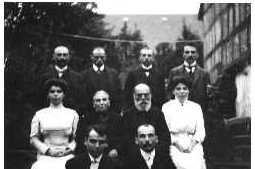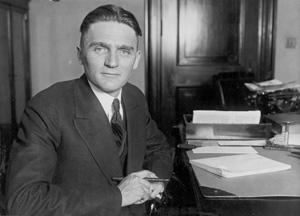HERMAN STERN -- TO AMERICA
For a list of German Jewish families who immigrated to the United States, and their stories, click on text below.
 |
|
Herman Stern likely had a professional photographer in Mainz make this portrait in 1902-3, before he left Germany for North Dakota. |
When Morris Straus asked Hermann Stern if he would like to come to America and go into the clothing business, he told the young man he wanted a good reliable member of the family to help him as he opened more stores. But the Stern family lore has it that Straus selected Stern not only as a potential manager for a second store, but that he also had taken his measure as a potential husband for his sister-in-law, who was living in his home. Whether this story is true or not, Stern did later marry Adeline Roth, the girl.
Anxious to get to the United States, young Stern asked his Mainz employer to let him out of his apprenticeship. The man refused to release him, but Stern left anyway, going to Hamburg and taking passage there on a ship for New York City. Arriving in New York, he was met by David Roth, Straus's brother-in-law, who gave him sixteen dollars for a train ticket to North Dakota. Stern quickly learned that the United States had different customs from Germany. During his train ride he couldn't think why the train porters acted so stiff, even cold, with him. Only after arriving in Casselton and telling Straus about his experience did he discover the problem: he never realized he was supposed to tip them!
In Casselton, Herman (who quickly dropped the second 'n' in his name) settled down to learn the business of men's clothing. He worked for Straus at the Casselton store until 1907, when Straus bought another store in Valley City. Moving to valley City to take charge of the new store, Straus made Herman manager of the Casselton shop. This arrangement lasted until 1910, when Straus, who was getting on in years, returned to Casselton, and Stern moved to valley City to take charge of the larger store.
Two years later, Stern married Adeline Roth, Morris Straus's sister-in-law. By that time, he was well on his way to becoming a full partner with Straus.
 |
| Herman Stern, on a return visit to his family in Germany, 1920s. Left to right, front row: Herman and brother Sallie; middle row: Dora, Mina and Samuel, Jettchen; last row: Adolph, Moses, Julius, Gustav. Dora Stern died of natural causes in 1934, and another brother, Salli had died in the 1919 flu epidemic. |
 Mr.
Stern found a surprising ally in his efforts to help German Jews get to America:
North Dakota Senator Gerald Nye. Nye (pictured at right) was an ardent exponent
of American neutrality, and would in 1941 be accused of anti-Semitism because
of his criticism of Hollywood's pro-British and anti-Nazi motion pictures.
But in the 1930s he regularly helped Stern cut paths through the State Department's
bureaucratic obstacles. On at least two occasions Nye addressed letters personally
to Secretary of State Cordell Hull, asking him to intervene in visa applications
for people Stern wanted to sponsor.
Mr.
Stern found a surprising ally in his efforts to help German Jews get to America:
North Dakota Senator Gerald Nye. Nye (pictured at right) was an ardent exponent
of American neutrality, and would in 1941 be accused of anti-Semitism because
of his criticism of Hollywood's pro-British and anti-Nazi motion pictures.
But in the 1930s he regularly helped Stern cut paths through the State Department's
bureaucratic obstacles. On at least two occasions Nye addressed letters personally
to Secretary of State Cordell Hull, asking him to intervene in visa applications
for people Stern wanted to sponsor.